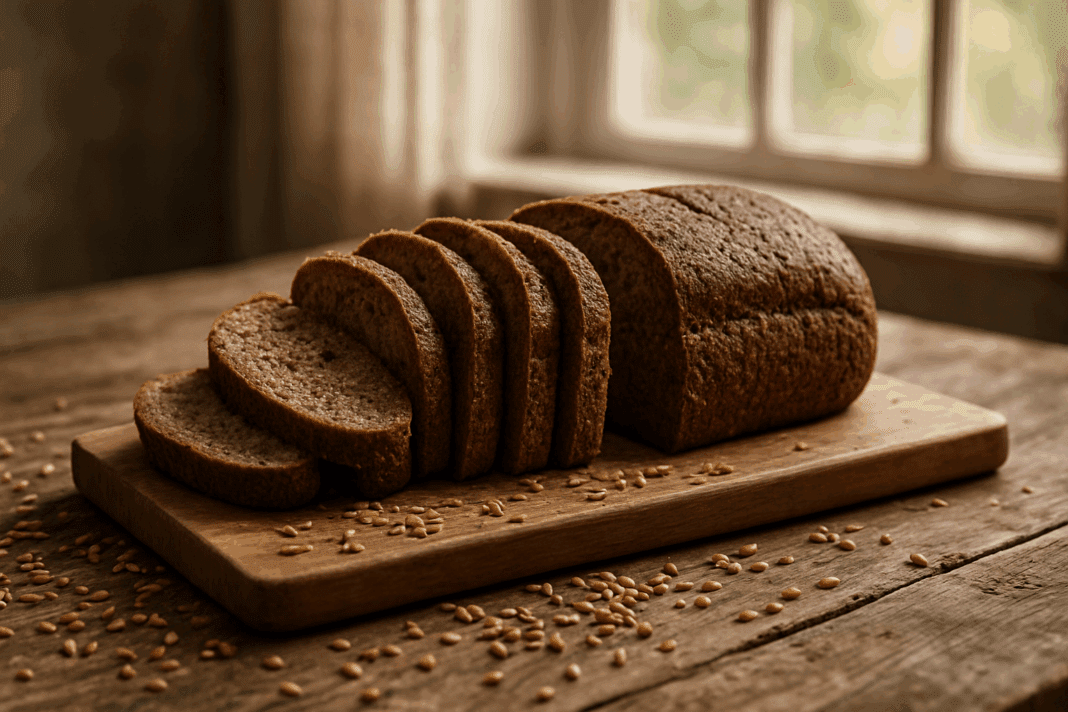In a world flooded with dietary trends and nutrition advice, the humble loaf of bread often finds itself at the center of controversy. While white bread has long been a staple in many households, whole grain bread has gained increasing recognition among health-conscious consumers. As discussions about healthy eating evolve, a key question continues to surface: Is whole grain bread good for you? And more specifically, what are the benefits to whole wheat bread compared to its refined counterparts? This article dives deep into the science, nutrition, and practical realities behind whole grain consumption, revealing why experts overwhelmingly advocate for its place in a healthy lifestyle.
You may also like: How a Whole Foods Diet Supports Sustainable Weight Loss: Expert Tips for Eating Whole Foods to Lose Weight Safely
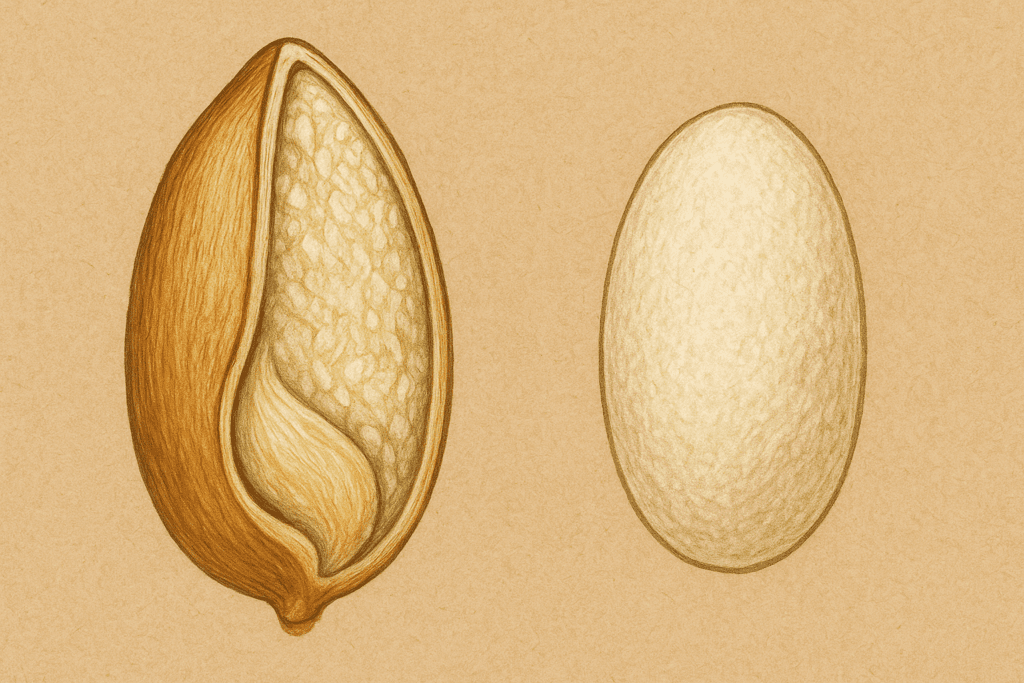
Understanding the Basics:
What Makes Bread Whole Grain? Whole grain bread, as the name implies, is made using flour that contains the entire grain kernel — the bran, germ, and endosperm. This is in stark contrast to refined grain bread, where the bran and germ are removed during processing, stripping away much of the grain’s nutritional value. The retention of all parts of the grain is what gives whole grain bread its hearty texture, nutty flavor, and most importantly, its powerful nutritional profile.
The benefits of wheat bread stem largely from this structural integrity. When we examine the nutritional factors of whole grain bread, it’s clear that whole wheat varieties contain more fiber, vitamins (especially B vitamins), antioxidants, and trace minerals like iron, magnesium, and zinc than refined breads. These nutritional advantages of whole wheat bread make it a superior option for those seeking to boost their diet with minimally processed, nutrient-dense foods.
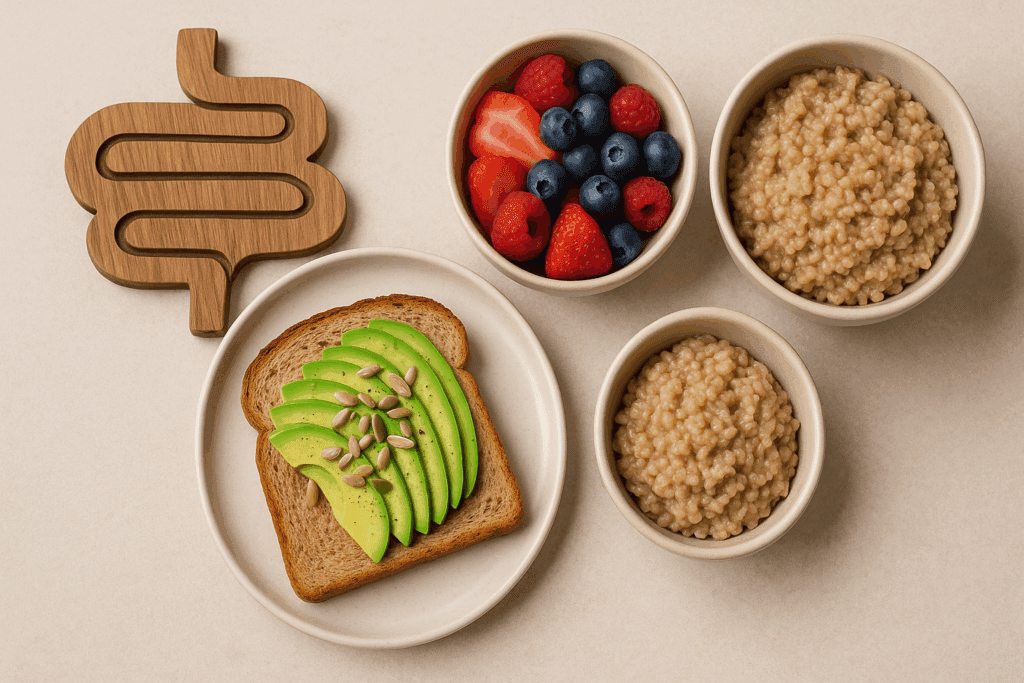
Whole Wheat Bread and Digestive Health:
The Fiber Advantage Fiber is one of the standout benefits of whole wheat bread. Because whole grain bread retains the bran layer of the grain, it provides a significant amount of dietary fiber, which is essential for digestive health. Fiber adds bulk to the stool, promotes regular bowel movements, and helps prevent constipation. Moreover, high-fiber diets have been associated with a reduced risk of colorectal cancer and diverticulitis.
But the role of fiber doesn’t end there. Soluble fiber in whole grain wheat bread helps lower LDL cholesterol by binding to it in the digestive tract, effectively removing it from the body. Insoluble fiber supports gut health by feeding beneficial bacteria and improving gut motility. These combined effects underscore why wholemeal bread benefits not just digestion, but also cardiovascular and metabolic health. This is yet another reason why dietitians affirm that whole grain bread is good for you.

Blood Sugar and Energy:
How Whole Wheat Bread Supports Glucose Control For individuals concerned about blood sugar, especially those with prediabetes or type 2 diabetes, choosing the right carbohydrates is crucial. Refined grain products often lead to rapid spikes in blood glucose due to their low fiber content and high glycemic index. In contrast, whole grain wheat bread digests more slowly, providing a gradual release of glucose into the bloodstream.
This steady digestion helps prevent the energy crashes and hunger pangs associated with high-glycemic foods. As a result, one of the key advantages of whole wheat bread is its ability to support more stable energy levels throughout the day. This characteristic makes it a smart choice for those trying to manage weight, reduce sugar cravings, or follow a balanced eating plan. So, when asking whether is wheat bread good for you, its role in stabilizing blood sugar provides a resounding yes.
Is Whole Grain Bread Fattening? Debunking a Common Myth A recurring concern among those watching their weight is whether whole grain bread contributes to fat gain. The truth is more nuanced. While all bread contains calories, it is the overall diet, lifestyle, and portion control that determine whether weight gain occurs. Whole grain bread, with its fiber-rich composition, actually promotes satiety, helping individuals feel fuller for longer.
Scientific studies show that individuals who consume whole grains regularly tend to have lower body weights and waist circumferences than those who consume primarily refined grains. This is because whole grains contribute to better appetite regulation, improved insulin sensitivity, and lower levels of systemic inflammation. Therefore, contrary to the misconception, the question “is whole grain bread fattening?” should be reframed. When eaten mindfully, whole grain bread is a tool for weight management — not a culprit of weight gain.
Heart Health and the Role of Whole Grains Whole grain bread offers multiple benefits for cardiovascular health. Diets high in whole grains have been linked to lower risks of heart disease, primarily due to their ability to reduce blood pressure, decrease bad cholesterol (LDL), and improve endothelial function. These heart-protective effects are attributed to the complex carbohydrates, plant sterols, and phytonutrients found in whole grain wheat.
Furthermore, the magnesium found in whole grain bread supports heart rhythm stability and muscle function, while antioxidants help combat oxidative stress, a contributing factor in atherosclerosis. When considering the benefits of wheat bread in the context of heart health, the evidence consistently favors its inclusion in a heart-conscious diet. Choosing whole grain over refined bread is a small but significant step toward a healthier cardiovascular system.
Whole Wheat Bread and Nutrient Density Beyond fiber and heart benefits, the nutritional factors of whole grain bread extend to its impressive vitamin and mineral profile. Whole wheat bread is a natural source of B vitamins, including niacin, thiamine, and folate, which are essential for energy metabolism, brain function, and red blood cell production. It also contains selenium, which plays a critical role in thyroid health and immune defense.
Iron and zinc are more bioavailable in whole grain bread when it is made using traditional fermentation or sourdough techniques, which reduce phytic acid content — a compound that can inhibit mineral absorption. In this way, whole grain flour is good for you not only for its macronutrient value but also for its micronutrient richness. This nutrient density contributes to better overall health and resilience against nutrient deficiencies.
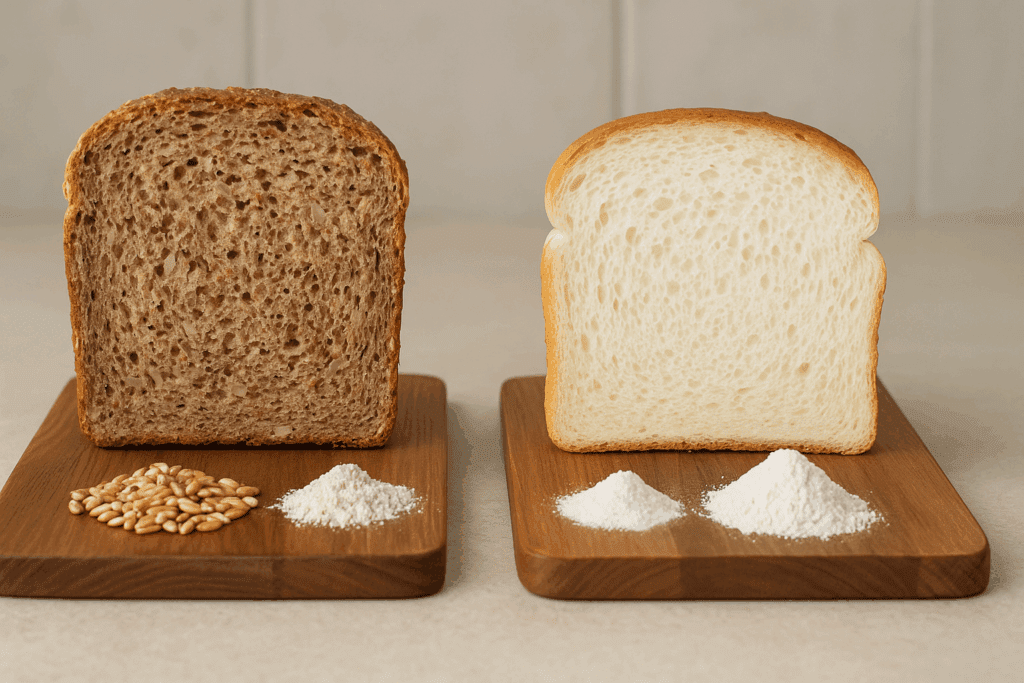
Whole Grain Bread vs. Refined Bread:
A Comparative Look Comparing whole grain bread to its refined counterpart reveals stark differences in both nutritional content and long-term health impact. Refined white bread, while soft and often preferred for its texture, lacks the fiber and many essential nutrients stripped during processing. Although some manufacturers enrich white bread by adding back certain vitamins, this process does not restore the full spectrum of health benefits naturally present in whole grain wheat bread.
When evaluating whether whole wheat bread is healthy, the comparison with refined bread is instructive. Whole grain bread not only supports better digestion, energy regulation, and heart health, but it also fosters a more sustainable diet that aligns with dietary guidelines set forth by major health organizations. The advantages of wheat bread become even clearer when viewed through this comparative lens.
Is Whole Wheat Bread Bad for You? Addressing the Controversies Despite its benefits, some skepticism remains around whole wheat bread, especially in light of low-carb and grain-free diet trends. Critics argue that wheat can cause inflammation, bloating, or blood sugar issues. However, it’s important to distinguish between processed grain products and minimally processed whole grain options. In individuals without celiac disease or diagnosed gluten sensitivity, there is no scientific basis to suggest that whole wheat bread is bad for you.
On the contrary, studies consistently support the health benefits of whole grains for the general population. While moderation is key, the question “is wheat bread bad for you?” is often rooted in misinformation or confusion between refined and whole grain varieties. For most people, the advantages of whole wheat bread far outweigh any perceived risks, especially when it’s consumed as part of a balanced, varied diet.

Wholemeal Bread Benefits in Everyday Eating Incorporating wholemeal bread into daily meals can be both easy and enjoyable. Its robust flavor pairs well with a variety of healthy toppings like avocado, hummus, lean proteins, or nut butters. Using whole wheat bread for sandwiches, toast, or as a base for open-faced meals makes it a versatile tool for healthy eating.
The benefits of wheat extend into lifestyle choices that prioritize whole, minimally processed foods. When people ask, “is whole bread good for you?” they are often referring to this broader commitment to mindful eating. Whole grain wheat bread encourages consumers to think critically about their food sources and choose items that nourish both body and mind. The advantages of whole wheat bread extend well beyond the nutrient label — they reflect a cultural and dietary shift toward wellness.
Is Wheat Good for You? A Look Beyond Bread Wheat, in its whole form, is an agricultural cornerstone that provides sustenance across the globe. The question “is wheat good for you?” or its colloquial variant “is wheat good for u” deserves a contextual answer. Whole wheat, as used in bread, pasta, and cereals, delivers a range of health benefits when consumed in its unrefined state. It supports energy production, satiety, and metabolic health.
However, as with any food, balance matters. Overconsumption of any single food group can crowd out dietary diversity. But when consumed as part of a well-rounded diet, wheat plays a valuable role in delivering fiber, plant protein, and essential nutrients. For the average adult without gluten intolerance, whole wheat is good for health and represents a wise carbohydrate choice.

How to Choose the Right Whole Grain Bread Not all products labeled “whole grain” are created equal. To maximize the advantages of wheat bread, it’s essential to read labels carefully. Look for terms like “100% whole wheat” or “whole grain” as the first ingredient. Avoid products where enriched flour or refined grains are listed early in the ingredient list, as these dilute the health benefits.
Also consider the overall ingredient quality — breads with fewer additives, preservatives, and added sugars are better aligned with a clean eating philosophy. Ideally, a nutritious loaf of whole grain wheat bread will contain whole food ingredients, use traditional preparation methods, and avoid unnecessary fillers. This attention to detail helps consumers experience the full spectrum of whole grain bread benefits.
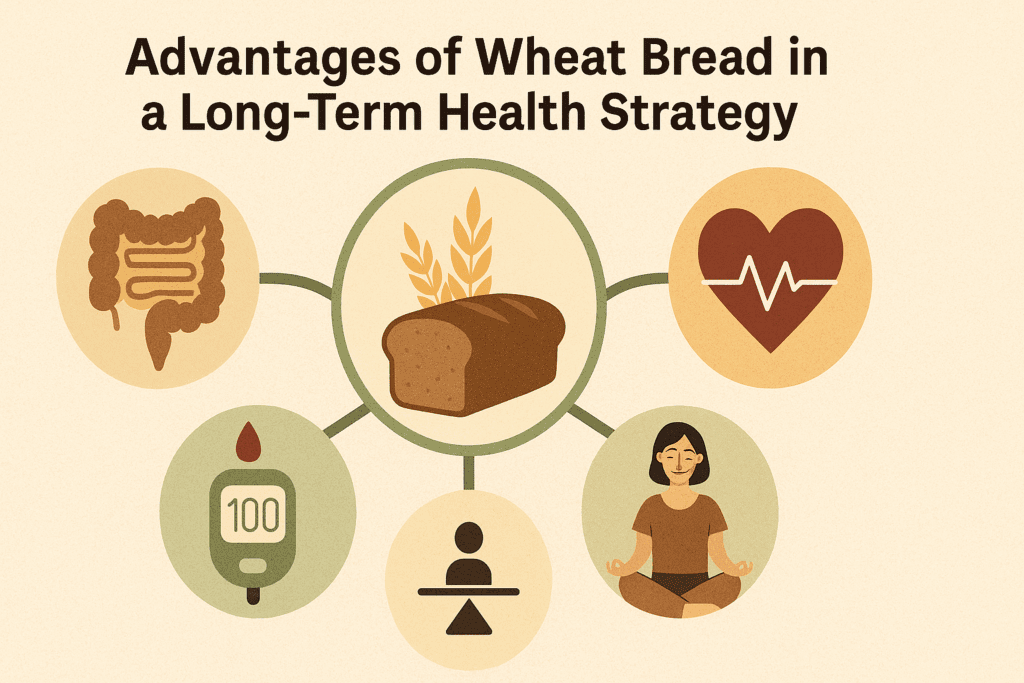
Advantages of Wheat Bread in a Long-Term Health Strategy Whole wheat bread can be more than a pantry staple — it can serve as a foundational component of a sustainable health strategy. By replacing refined grains with whole wheat options, individuals reduce their risk of chronic diseases, support digestive and cardiovascular health, and improve nutritional intake.
This transition also reflects broader dietary patterns recommended by experts, including the Mediterranean and DASH diets, both of which emphasize whole grains. The advantages of wheat bread are most profound when it replaces less nutritious alternatives and is paired with diverse, plant-forward meals. In this way, the benefits of wheat bread are not only personal but societal, contributing to better public health outcomes.
Frequently Asked Questions: Whole Grain and Whole Wheat Bread
1. Can switching to whole wheat bread help improve mental clarity or cognitive function?
Yes, choosing whole wheat bread over refined options may support better cognitive performance, particularly in the long term. The nutritional factors of whole grain bread include a rich supply of B vitamins, especially folate and thiamine, which are essential for brain health. Additionally, the steady glucose release from whole grain wheat bread supports consistent energy to the brain, avoiding the spikes and crashes that refined carbs can trigger. Emerging research also points to a possible link between high-fiber diets and reduced risk of age-related cognitive decline. These insights expand the discussion around the benefits of wheat bread, suggesting its potential influence on mental acuity and neurological wellness.
2. How does whole grain bread affect hormonal health, especially in women?
Hormonal balance is influenced by many dietary factors, and whole grain bread plays a unique role in this dynamic. Due to the fiber content and slow-releasing carbohydrates in wholemeal bread, insulin levels remain more stable, which supports better hormonal regulation. This is particularly important for women managing conditions like polycystic ovary syndrome (PCOS), where insulin sensitivity is a concern. Additionally, is whole grain flour good for you in terms of hormonal health? Yes — it also contains phytoestrogens that may help modulate estrogen levels naturally. While not a cure-all, whole grain bread can contribute to hormonal stability when included as part of a balanced diet.
3. Is whole grain bread fattening when consumed at night?
The timing of carbohydrate consumption often sparks debate, especially when it comes to weight gain. However, whether or not is whole grain bread fattening at night depends more on portion size and what it’s paired with than the bread itself. Because whole grain bread promotes satiety, a small slice in the evening — particularly when eaten with a protein or healthy fat — may actually curb late-night snacking. It’s a myth that eating whole grains at night inherently leads to fat storage. The real consideration lies in total daily caloric intake and dietary balance. So if you’re asking, “is whole grain bread good for you in the evening?” — it can be, when part of a well-portioned, nutritious meal.
4. What are the social or cultural implications of shifting from white to whole grain bread?
Dietary habits are often culturally ingrained, and switching from refined to whole grain wheat bread can reflect broader social trends toward wellness and sustainability. In many Western countries, whole grain bread has become a symbol of health-conscious eating. This shift not only supports personal health — highlighting the advantages of whole wheat bread — but also encourages demand for agricultural practices that favor less processing and more sustainable grain use. Whole bread is good for you individually, but choosing it can also signal participation in a larger movement toward conscious consumption. This aligns with both public health goals and environmentally responsible food systems.
5. Are there advantages of wheat bread for people recovering from illness or surgery?
Yes, wheat bread can support recovery in several meaningful ways. The benefits of wheat include a combination of B vitamins, iron, and complex carbohydrates that assist in cellular repair and energy replenishment. The whole grain wheat bread’s slower digestion can also help patients maintain more consistent energy levels without dramatic blood sugar fluctuations. In individuals who are regaining strength, whole grain bread’s nutritional profile aids in rebuilding physical endurance and supporting immune function. So, when considering what are benefits to whole wheat bread in recovery, it becomes clear that its role goes beyond simple nourishment.
6. How does whole grain bread compare nutritionally to trendy low-carb alternatives like almond or coconut flour breads?
Low-carb breads have gained popularity, especially in ketogenic and paleo diets. However, the nutritional factors of whole grain bread offer benefits that many of these alternatives cannot replicate. For example, whole grain wheat bread delivers dietary fiber, manganese, selenium, and magnesium — nutrients not always found in nut- or seed-based loaves. While almond and coconut flour options are low in carbs, they often lack the whole food balance that whole grain varieties provide. If you’re asking, “is grain bread good for you compared to other health trends?” — the answer is yes, particularly when it comes to achieving nutrient diversity and long-term satiety.
7. Can children benefit from eating whole wheat bread, or is it more suitable for adults?
Whole wheat bread is equally beneficial for children, especially as they develop taste preferences and nutritional habits. The advantages of wheat bread for children include sustained energy release during school hours, improved digestive health, and better concentration due to blood sugar stability. Introducing whole grain bread early can also reduce resistance to high-fiber foods later in life. Because is wheat good for you applies to all age groups, building a child’s diet around whole foods like whole wheat bread sets a foundation for lifelong wellness. This proactive approach supports growth, learning, and healthy metabolism from a young age.
8. Are there any emerging innovations in whole grain bread that enhance its health benefits even further?
Yes, food scientists and artisan bakers are exploring new methods to enhance the benefits of wheat bread. For instance, fermentation techniques like sourdough preparation can improve mineral absorption and gut health due to reduced phytic acid content. There’s also a trend toward sprouted whole grain breads, which may offer better digestibility and increased bioavailability of nutrients. Is whole grain wheat bread good for you when sprouted? Studies suggest that sprouted grains may have superior antioxidant levels and slightly higher protein content. These innovations demonstrate how the nutritional value of grain-based foods continues to evolve.
9. Can consuming whole grain bread affect skin health or appearance?
Although not often discussed, skin health may be subtly influenced by the nutritional makeup of your diet, including your choice of bread. Whole grain bread contains antioxidants like selenium and zinc, both of which support collagen production and skin barrier repair. The question “is whole grain bread healthy for you in terms of skin?” opens up an underexplored but meaningful conversation. Moreover, the anti-inflammatory properties of a high-fiber diet may reduce skin flare-ups such as acne. When evaluating the wholemeal bread benefits, improved skin appearance may be an indirect but welcome bonus.
10. What misconceptions lead people to believe that whole wheat bread is bad for them?
A growing number of people avoid wheat due to concerns fueled by diet culture and misinformation. The question “is whole wheat bread bad for you?” often arises from confusion between gluten intolerance and general wellness. Many also mistake all carbohydrate sources as harmful, ignoring the advantages of whole wheat bread rooted in its intact nutritional structure. While some individuals do require gluten-free diets, the broader population can safely enjoy wheat without adverse effects. In fact, is wheat is good for health becomes an important distinction when debunking myths and separating medical necessity from marketing trends.
Conclusion:
Embracing the Nutritional Power of Whole Wheat Bread After a thorough examination of its nutritional profile, health implications, and practical applications, the answer to the question “is whole grain bread good for you?” is a decisive yes. The advantages of whole wheat bread are vast — from digestive support and blood sugar balance to cardiovascular protection and nutrient density. Its inclusion in a mindful eating plan reinforces the importance of whole foods in achieving long-term wellness.
For those wondering “what are benefits to whole wheat bread,” or questioning “is wheat bread good for you,” the evidence is both scientifically sound and practically compelling. Whole grain wheat bread is not fattening when eaten in moderation; it is not bad for your health unless you have a specific medical condition requiring grain avoidance. In fact, the benefits of wheat — from its fiber and vitamin content to its role in balanced eating — make it a cornerstone of healthy living. By choosing breads made with whole grain flour and prioritizing quality ingredients, consumers can enjoy a flavorful, nourishing, and expert-backed way to support their health through every slice.
Was this article helpful? Don’t let it stop with you. Share it right now with someone who needs to see it—whether it’s a friend, a colleague, or your whole network. And if staying ahead on this topic matters to you, subscribe to this publication for the most up-to-date information. You’ll get the latest insights delivered straight to you—no searching, no missing out.
Further Reading:
9 Health Benefits of Eating Whole Grains
Whole-Grain Bread vs. Whole-Wheat Bread: What’s the Difference?
Disclaimer
The information contained in this article is provided for general informational purposes only and is not intended to serve as medical, legal, or professional advice. While NewsHealthWatch strives to present accurate, up-to-date, and reliable content, no warranty or guarantee, expressed or implied, is made regarding the completeness, accuracy, or adequacy of the information provided. Readers are strongly advised to seek the guidance of a qualified healthcare provider or other relevant professionals before acting on any information contained in this article. NewsHealthWatch, its authors, editors, and contributors expressly disclaim any liability for any damages, losses, or consequences arising directly or indirectly from the use, interpretation, or reliance on any information presented herein. The views and opinions expressed in this article are those of the author(s) and do not necessarily reflect the official policies or positions of NewsHealthWatch.

